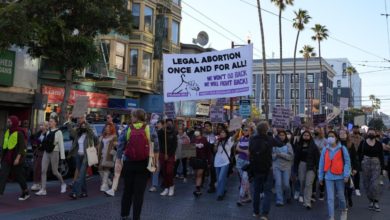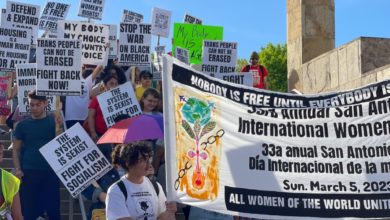Maria is a Dominican woman living in New York City. Domestic violence forced her and her 7-year-old daughter into a shelter. When she entered the shelter, she was employed as a home health aide. She worked 60 hours a week, earning $9 per hour.
 The daily challenges faced by working-class single mothers are not addressed by the welfare system. Photo: Bill Hackwell |
For security reasons, the shelter asked her to leave her job or, if possible, transfer to a new job location. But Maria’s employers were not able to transfer her to a safe location soon enough. If Maria had kept her job, the city would have declared her ineligible for housing assistance, charged her for her stay in the shelter and given her just 90 days to secure her own apartment.
Having left one dependency behind, Maria then had to choose between staying employed or becoming dependent on the welfare system. The rent for a standard New York City two-bedroom apartment ranges between $1,000 and $1,600 a month. Security deposit and first month’s rent total about three times the monthly charge up front. Maria decided the only way for her to survive with her child would be to quit her job and apply for welfare.
Maria’s enrollment in the welfare system meant she would receive food stamps and a cash assistance of $208 a month for her child. The city also offered her a housing subsidy and childcare. In return, Maria would be required to work 35 hours a week in a city “workfare” program at a location that welfare services deemed safe and adequate.
The city requires women who are in domestic violence shelters to wait 42 days to become eligible for a Housing Stability Plus voucher. A family the size of Maria’s would receive a voucher of $820 per month but would not be allowed to rent any apartment that exceeded that figure.
This limitation produces “under the table” deals with landlords and real estate agents, and often leads a homeless family like Maria’s to accept apartments with dangerous living conditions.
The voucher remains available for five years, decreasing by 20 percent every year until it is eliminated entirely. The catch is that women are required to keep their welfare cases open to continue receiving the voucher. To keep the welfare case open, however, they cannot hold a job that pays more than $180 a week.
The trap is inescapable. How can she get her family back on its feet if she knows assistance will be cut the moment she finds a job?
After three months in the shelter, Maria had had enough and returned to work as a home health aide. Immediately she lost her $208 cash assistance and childcare eligibility. She would only be able to keep her housing voucher as long as her welfare case was open. To remain eligible, Maria could not make more than $180 per week elsewhere, and she would still have to meet the 35 hours of work per week requirement to the “workfare” program.
Not able to meet the salary restrictions or pay for childcare, household and child expenses, Maria again stopped working as a home health aide and returned to the welfare system. Unfortunately, Maria’s story is hardly unique.
Domestic violence is the leading cause of injury to women. Each year, 5.3 million women are abused and 1,232 women are killed by an intimate partner. Intimate-partner violence victims lose nearly eight million days of work per year. Nearly $4.1 billion is spent yearly on victims requiring direct medical and mental care services as a result of rape or assault.
Yet when these women enter the welfare system in search of assistance, they are immediately thrown into a web of contradictory requirements and endless bureaucracy that perpetuates confusion, entrapment and leaves them without options.
A social gain won in struggle
During the Depression, welfare was introduced as part of a package of the New Deal policies, which also included unemployment insurance and social security. These reforms were won because of mass protests and strikes of the 1930s. With the entire capitalist system under threat, the government decided to grant some relief to defuse the mounting tensions.
The Social Security Act of 1935 created Aid to Dependent Children (ADC). Originally known as the Mother’s Aid and later named Aid to Families with Dependent Children, the reform was designed to provide economic support to families with children.
At the time, poor white women—particularly widows whom the Depression had made destitute—headed most families that received the aid. The welfare system aimed to provide the necessary economic support to allow these women to raise their children without entering the workforce.
At its conception, the framers of the welfare system expected women’s primary responsibility to be the bearing of children, while men would be the “breadwinners.” When men were not present, the government assumed financial responsibility for these families.
“The ADC, however, only allowed mothers who were ‘deserving’ of assistance to enroll in the welfare program. Congress permitted states to consider the ‘moral character’ of the parent when determining aid for children under ADC, and women of color and mothers of children born out of wedlock were routinely denied support,” according to a 2003 report of the Lawyers Committee for Civil Rights Under Law.
Congress amended the Social Security Act in 1962 and renamed the program Aid to Families with Dependent Children. The AFDC eliminated race and “moral character” restrictions for the first time, thus allowing Black families to become eligible for the AFDC program.
The 1962 amendment and the AFDC’s increased enrollment from 3 million recipients in 1960 to 11 million in 1975 were a direct result of the mass civil rights and later welfare rights movements of the 1960s and early 1970s.
Clinton’s welfare ‘reform’
In 1996, the Clinton administration “reformed” welfare. AFDC was replaced by the Temporary Assistance to Needy Families program. That program is in effect today, although it technically expired in 2005. This “reform” greatly increases the requirements and limitations imposed on welfare recipients.
For example, single parents must work 30 hours per week in menial “workfare” jobs to receive assistance. Underage parents must live with guardians, and all mothers must establish the paternity of their child.
The 1996 “reforms” also eliminated welfare as a federally administered program. Instead, grants were handed over to individual states, which were given control over their respective welfare cases. Many states enlisted corporations and religious organizations to administer their programs.
It is no surprise then that in many Black and Latino communities, welfare’s perceived function changed from social support to social control.
This was not a hidden conspiracy, although it was masked by coded language about family planning. Two of the Temporary Assistance to Needy Families programs stated that their goals are to “prevent and reduce the incidence of out-of-wedlock pregnancies” and “encourage the formation and maintenance of two-parent families.” The message was that it was the poor who were to blame for their poverty rather than a system based on pervasive, all-around racist discrimination and large-scale unemployment.
The welfare overhaul was accompanied by a racist media campaign that, in lockstep with the right wing, particularly depicted African American and Latina women welfare recipients as lazy, promiscuous “freeloaders.” The racist campaign never portrays the “deserving poor”—presumably the white women for whom the New Deal welfare program was created—instead focusing on “undeserving poor” portrayed as mothers of illegitimate children with poor parenting skills.
According to this campaign, while the “deserving poor” fell upon hard times due to personal misfortune and structural economic conditions, the situation of the “undeserving poor” was caused by character or cultural defects, poor morals and deviant behavior.
After the 1996 welfare “reform,” Maria would find herself categorized by the right-wing media as undisciplined, dependent, ignorant, dishonest and a “foreign” freeloader.
When the number of welfare cases immediately dropped after the implementation of the Temporary Assistance for Needy Families programs, conservatives and the Clinton administration alike celebrated the news as validation of the new “workfare” system.
But the fact is that only 21 percent of those who left welfare did so because they found a job. Most were simply taken off federal assistance for missing appointments, improperly filling out paperwork or failing to comply with a litany of other requirements.
And, as the case of Maria shows, finding a job is often not the answer to systemic poverty. Forty percent of the 3.5 million homeless people in 2003 worked full or part time.
‘Workfare’ and the workforce
The new “workfare” reforms have facilitated the growing instability and job insecurity of the working class as a whole. It creates a second tier of workers, who do not receive adequate job training and are forced into menial manual labor. Those workers then directly compete with unionized workers. For instance, 45,000 welfare recipients now clean New York City’s streets and subways. Previously, these were unionized jobs.
The 1996 Clinton welfare cuts were a step back for the working class. How many women like Maria have had to leave their jobs and completely rearrange their lives in order to comply with welfare’s impossible work requirements? How many women have fallen through the cracks, lost cash assistance, food stamps and Medicaid, and become desperate for any job?
While creating divisions in the working class, the current welfare system consciously stigmatizes and demoralizes its recipients. As an example of the ever-present racist campaign against them, New York City welfare recipients were forced to wear humiliating bright orange vests—like the old “chain gangs” of jail inmates—as they went about the streets and subways with their brooms and trash baskets.
The limits of capitalist welfare
While women like Maria struggle to make ends meet in the United States, the world’s wealthiest nation, women in Cuba readily find assistance in their struggle against domestic violence and poverty. In Cuba, domestic violence is viewed and addressed as a social problem, not a personal one.
Cuba’s government has taken great steps to attack the patriarchal social relations inherited from capitalism. Women in Cuba enjoy equal pay, have the same educational opportunities and do the same jobs as men.
Thanks to the government’s planned economy, which carefully calculates the country’s housing needs and allocates its resources accordingly, homelessness has been virtually eliminated. Where one rich family once occupied mansions and manors, now several families share the space.
Articles may be reprinted with credit to Socialism and Liberation magazine.






